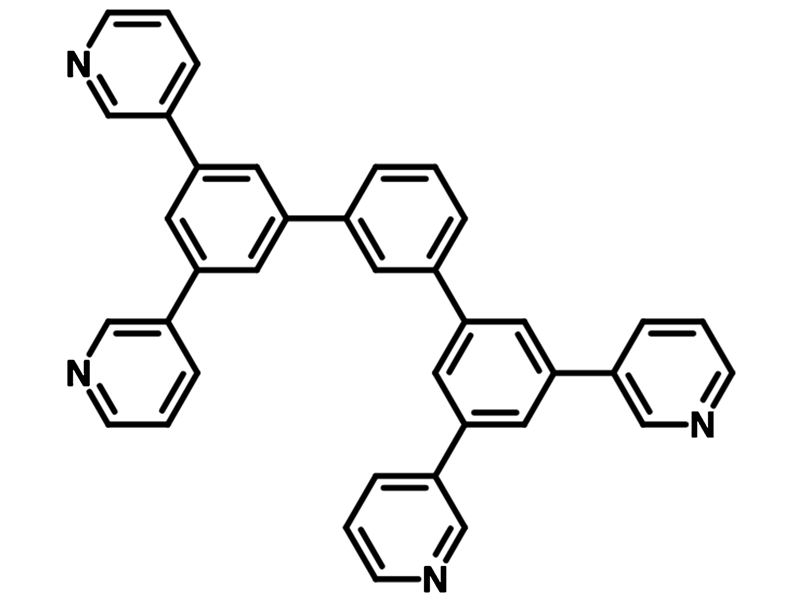CAS Number 1030380-38-1


Used to improve the performance of PhOLEDs, 1,3-Bis(3,5-dipyrid-3-ylphenyl)benzene, CAS No. 1030380-38-1, 1,3-Bis[3,5-di(pyridin-3-yl)phenyl]benzene, BmPyPB, BmPyPhB
Bearing four pyridyl groups, B3PyPB is electron deficient and has high electron mobility. It is widely used as an electron-transport material (ETL) in OLED devices. With a deep HOMO energy level (6.60 eV), B3PyPB is also used as a hole-blocking layer material (EBL).
Having a high triplet energy (ET = 2.77 eV), B3PyPB is used in phosphorescent OLEDs to suppress triplet quenching of the light-emitting molecules, leading to higher external quantum efficiency - hence improving the device performance.
| CAS number | 1030380-38-1 |
|---|---|
| Full name | 1,3-Bis(3,5-dipyrid-3-ylphenyl)benzene |
| Chemical formula | C38H26N4 |
| Molecular weight | 538.64 g/mol |
| Absorption | λmax 259 nm in film |
| Fluorescence | λem 359 nm in film |
| HOMO/LUMO | HOMO 6.60 eV, LUMO 2.60 eV [1] |
| Synonyms | 1,3-Bis[3,5-di(pyridin-3-yl)phenyl]benzene, BmPyPB, BmPyPhB |
| Classification / Family | Organic electronics, Hole blocking layer materials (HBL), Electron transporting layer materials (ETL), TADF-OLEDs, Sublimed materials. |
| Purity | Sublimed: >99.0% (HPLC) |
|---|---|
| Melting point | TGA: >350 °C (0.5% weight loss) |
| Colour | White powder/crystals |
*Sublimation is a technique used to obtain ultra pure-grade chemicals. For more details about sublimation, please refer to the Sublimed Materials.
 Chemical structure of 1,3-Bis(3,5-dipyrid-3-ylphenyl)benzene (B3PyPB), CAS 1030380-38-1
Chemical structure of 1,3-Bis(3,5-dipyrid-3-ylphenyl)benzene (B3PyPB), CAS 1030380-38-1
| Device structure | ITO (130 nm)/TAPC (60 nm)/TCTA:7 wt% FIrpic (5 nm)/TCTA:FIrpic 20 wt% (5 nm)/B3PyPB (20 nm)/ B3PyPB:25 wt% Liq (35 nm)/Liq (1 nm)/Al (100 nm) [2] |
|---|---|
| Colour |
Blue |
| Current Efficiency@100 cd/m2 | 51.6 cd/A |
| EQE@100 cd/m2 | 21.8% |
| Power Efficiency@100 cd/m2 | 56.5 lm W-1 |
| Device structure | ITO (130 nm)/TAPC (60 nm)/TCTA:7 wt% FIrpic (5 nm)/TCTA:FIrpic 20 wt% (5 nm)/B3PyPB (20 nm)/B3PyPB:25wt% Liq (35 nm)/Liq (1 nm)/Al (1 nm)/MoO3 (5 nm)/TAPC (60 nm)/TCTA:7 wt% FIrpic (5 nm)/TCTA: FIrpic 20 wt% (10 nm)/B3PyPB (20 nm)/B3PyPB: 25wt% Liq (35 nm /Liq (1 nm) [2] |
|---|---|
| Colour |
Blue |
| Current Efficiency@100 cd/m2 | 90.0 cd/A |
| EQE@100 cd/m2 | 41.1% |
| Power Efficiency@100 cd/m2 | 40.8 lm W-1 |
| Device structure | ITO/triphenylamine-containing polymer: PPBI (20 nm)/TAPC (20 nm)/ 10 wt% CzAc-26DPPM:mCP (10 nm)/10 wt% CzAc-26DPPM:DPEPO (10 nm)/B3PyPB (50 nm)/LiF (0.5 nm)/Al (100 nm) [3] |
|---|---|
| Colour |
Blue |
| Current Efficiency@100 cd/m2 | 53.9 cd/A |
| EQE@100 cd/m2 | 22.8% |
| Power Efficiency@100 cd/m2 | 59.2 lm W-1 |
| Device structure | ITO/triphenylamine-containing polymer: PPBI* (20 nm)/TAPC (20 nm)/ 10 wt% CzAc-26DPPM:mCP (10 nm)/10 wt% CzAc-26DPPM:DPEPO (10 nm)/B3PyPB (50 nm)/LiF (0.5 nm)/Al (100 nm) [4] |
|---|---|
| Colour |
Blue |
| Max. Current Efficiency | 28.6 cd/A |
| Max. EQE | 18.6% |
| Max. Power Efficiency | 35.9 lm W-1 |
| Device structure | ITO (130 nm)/TAPC (40 nm)/TCTA (5 nm)/ PQ2Ir(dpm) 2 wt % doped CBP (1 nm)/Ir(ppy)3 6 wt % doped CBP (1 nm)/Ir(dbfmi)* 10 wt % doped PO9 (10 nm)/B3PyPB (50 nm)/LiF (0.5 nm)/Al (100 nm) [4] |
|---|---|
| Colour |
White |
| Max. Current Efficiency | 53.7 cd/A |
| Max. EQE | 23.3% |
| Max. Power Efficiency | 55.2 lm W-1 |
| Device structure | ITO (130 nm)/TAPC (35 nm)/5 wt% 4CzIPN-doped CBP (15 nm)/B3PyPB (65 nm)/LiF (0.8 nm)/Al (100 nm) [5] |
|---|---|
| Colour |
Green |
| Max Current Efficiency | 71.2 cd/A |
| Max EQE | 21.8% |
| Max. Power Efficiency | 60.9 lm W-1 |
| Device structure | ITO (90 nm)/HATCN (5 nm)/TAPC (65 nm)/10 wt% fac -Ir(mpim)3 -doped TCTA (5 nm)/10 wt% fac -Ir(mpim)3 -doped 26DCzPPy (5 nm)/B3PyPB (65 nm)/Liq (2 nm)/Al (80 nm) [6] |
|---|---|
| Colour |
Blue |
| Current Efficiency@100 cd/m2 | 73.2 cd/A |
| EQE@100 cd/m2 | 29.6% |
| Power Efficiency@100 cd/m2 | 76.5 lm W-1 |
专业代理国外知名镊子品牌
我们将竭诚为你服务
0755-23003036